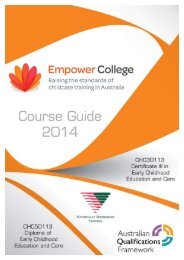Peer coaching booklet
You also want an ePaper? Increase the reach of your titles
YUMPU automatically turns print PDFs into web optimized ePapers that Google loves.
<strong>Peer</strong> <strong>coaching</strong> 2016<br />
Introduction session<br />
YOUR LOGO
Contents<br />
Introduction<br />
Why peer <strong>coaching</strong><br />
Culture of <strong>coaching</strong><br />
Coaching as professional<br />
development<br />
Coaching and<br />
retention<br />
3<br />
4<br />
5<br />
8<br />
11<br />
2<br />
<strong>Peer</strong> Coaching foundations
Introduction<br />
Welcome to the first step in your peer <strong>coaching</strong> journey!<br />
This information session is the first in a series of sessions that will assist you in understanding<br />
the theory behind peer <strong>coaching</strong> and how peer <strong>coaching</strong> can assist you in your training role at Linx<br />
Institute. Our intention in implementing<br />
the peer <strong>coaching</strong> program is to<br />
support you in your role and continue<br />
to develop your professional skills.<br />
I look forward to being part of your professional journey<br />
Tania Gomez<br />
General Manager<br />
<strong>Peer</strong> <strong>coaching</strong> foundations<br />
3
Eria nimoditatia voluptatas aut la<br />
nimint molore velenda debissitio.<br />
<strong>Peer</strong> <strong>coaching</strong> foundations<br />
4
<strong>Peer</strong> <strong>coaching</strong><br />
<strong>Peer</strong> <strong>coaching</strong> is a powerful tool used to<br />
support and develop teachers at all stage in<br />
their career. At Linx institute, we use peer<br />
<strong>coaching</strong> as a way to develop our staff,<br />
support retention and staff satisfaction as well<br />
as to ensure students outcomes.<br />
The benefits to peer <strong>coaching</strong> that Linx<br />
institute staff have expressed includes<br />
- Feeling valued and heard<br />
- Allowing time and space to improve their<br />
professional practice<br />
- Creating a culture that supports teachers<br />
and support staff alike<br />
- Allow a safe place to reflect, review and<br />
improve teaching methodologies<br />
<strong>Peer</strong> <strong>coaching</strong> foundations<br />
5
The culture of <strong>coaching</strong> and the literature<br />
Mann and Smith explore the viewpoint that a culture of <strong>coaching</strong><br />
creates purposeful connections with peers that supports ‘immediate<br />
change and stimulates long-term sustainable results’ (Mann and Smith,<br />
2015 p.36). Whilst Mann and Smith (2015) focus on corporate<br />
leadership, the concept and benefits of a culture of <strong>coaching</strong> are one that<br />
could be translated to teachers at all stages of their careers. This text<br />
emphasises the need for clear guidelines and outcomes to be decided<br />
upon prior to beginning <strong>coaching</strong>. In this case, the aspirations of the<br />
<strong>coaching</strong> program was to cultivate relationships, collaboration and being<br />
able to give and receive feedback in order to improve practice.<br />
Lofthouse and Leat (2013) further examine the sociocultural context<br />
needed to allow peer <strong>coaching</strong> to be beneficial and examines the<br />
reasons that <strong>coaching</strong> may not play the part its intended. Lofthouse and<br />
Leat (2013) observe that teachers encounter tension during peer<br />
<strong>coaching</strong> sessions based on unclear rules, power and trust issues and<br />
time constraints of leaders to devote to peer <strong>coaching</strong> programs.<br />
The contrast of the literature suggests that organisational intention<br />
and ‘buy in’ for a peer <strong>coaching</strong> program is crucial to ensure <strong>coaching</strong><br />
can meet the participant’s goals. This sentiment is echoed by Joyce and<br />
Showers (1996), who state that a cohesive school culture and the<br />
formation of peer <strong>coaching</strong> teams with diverse skills produce greater<br />
cohesion and focus.<br />
<strong>Peer</strong> <strong>coaching</strong> foundations<br />
6
Coaching as a<br />
professional<br />
development tool<br />
Showers and Joyce (1996) initially<br />
researched peer <strong>coaching</strong> in 1982<br />
and compared peer <strong>coaching</strong> to<br />
traditional in-service training. The<br />
study found that teachers who<br />
attended in-service training alone had<br />
a low rate of transfer and were not<br />
able to find ways to generally improve<br />
their practice from the in-service<br />
training alone. When peer <strong>coaching</strong><br />
was added the implementation of new<br />
teaching methodologies rose<br />
dramatically.<br />
Subheader<br />
Dolore repreicietur acillandus asitium aut fugia<br />
nimoluptate etur? Quibus con conem vendam<br />
eatet aborum nis quidebi ssitas et volupta ditior<br />
rem et harci optasincim quo te sequasim quam<br />
volupta ssequiamet asperionesto tem vendestint.<br />
Ut aci te officit veni rehendit, que doluptam<br />
que id magnat. Is autasit emporiatur sume<br />
landaerupta vid eosam doluptatius porerchic tem<br />
fugiae dolessediti vit, qui dolupti odiscil escipit<br />
ibusapelique pre, quodita tionsedite.Inu- stem re<br />
voluptat. Tium harum iuribus daerum expliquo<br />
verum solupta simus quae corepta tempore<br />
rspitinum et ulparci sitio. Et abo. Ma- iorpo<br />
rporatem hitio molu.<br />
Dolore repreicietur acillandus asitium aut fugia<br />
nimoluptate etur? Quibus con conem vendam<br />
eatet aborum nis quidebi ssitas et volupta ditior<br />
rem et harci optasincim quo te sequasim quam<br />
volupta ssequiamet asperionesto tem vendestint.<br />
Ut aci te officit veni rehendit, que doluptam<br />
que id magnat. Is autasit emporiatur sume<br />
landaerupta vid eosam doluptatius porerchic tem<br />
fugiae dolessediti vit, qui dolupti odiscil escipit<br />
ibusapelique pre, quodita tionsedite.Inu- stem re<br />
voluptat. Tium harum iuribus daerum expliquo<br />
verum solupta simus quae corepta tempore<br />
rspitinum et ulparci sitio. Et abo. Ma- iorpo<br />
rporatem hitio molu.<br />
Kohler (1997) built on the work of<br />
Showers and Joyce and found that<br />
peer <strong>coaching</strong> allows reflection of<br />
current practice and develops<br />
leadership and collaboration. Whilst<br />
Kohler used different procedures for<br />
initiating and measuring the success<br />
of peer <strong>coaching</strong>, his research<br />
concurred with that of Shower and<br />
Joyce (1996) that peer <strong>coaching</strong> has<br />
the ultimate goal of developing,<br />
refining and sustaining teaching<br />
methodologies in order to meet<br />
students diverse learning capabilities.<br />
Dolore repreicietur acillandus asitium aut fugia<br />
nimoluptate etur? Quibus con conem vendam<br />
eatet aborum nis quidebi ssitas et volupta ditior<br />
rem et harci optasincim quo te sequasim quam<br />
volupta ssequiamet asperionesto tem vendestint.<br />
Ut aci te officit veni rehendit, que doluptam<br />
que id magnat. Is autasit emporiatur sume<br />
landaerupta vid eosam doluptatius porerchic tem<br />
fugiae dolessediti vit, qui dolupti odiscil escipit<br />
ibusapelique pre.<br />
Chapman (2008) examines the history and<br />
cultural context of professional development<br />
training for teachers and finds that whilst both<br />
past and present professional development<br />
training focus on enhancing skills, the<br />
ideology is different. Today’s processional<br />
development focuses on the unique<br />
differences of the individual rather than the<br />
similarities of the group which is why peer<br />
<strong>coaching</strong> is seen as a favourable option.<br />
Waddell (2005) and Chapman (2008) agree<br />
that peer <strong>coaching</strong> is highly effective at<br />
transferring newly acquired knowledge and<br />
skills into teaching methodologies and<br />
strategies. Waddell (2005) states that peer<br />
<strong>coaching</strong> is used to close the gap between<br />
what a “book knowledge” and “practical<br />
knowledge”, also building upon the work of<br />
Showers and Joyce (1982).<br />
Waddell builds on this concept and adds the<br />
question of the effectiveness of <strong>coaching</strong><br />
being hinged to the effectiveness of the<br />
particular coach and highlights the need for<br />
training for those in <strong>coaching</strong> roles.<br />
Trautwein and Ammerman (2010) concur with<br />
Waddell and suggest that peer <strong>coaching</strong> has<br />
the ability to allow mastery to occur,<br />
especially in new or pre-service teachers.<br />
Further demonstrating this is the statistic of<br />
80% of pre-service teachers in peer <strong>coaching</strong><br />
models meeting their two stated <strong>coaching</strong><br />
objectives.<br />
<strong>Peer</strong> <strong>coaching</strong> foundations<br />
7
Coaching for staff<br />
satisfaction and<br />
retention<br />
Matthews and Lawley (2011) examined cohorts of teaching<br />
students and found that peer <strong>coaching</strong> done in the internship<br />
model increased participant satisfaction. Matthews and Lawley<br />
(2011) also reported a higher level of employability and both<br />
short and long term educational benefits as a result of the peer<br />
<strong>coaching</strong>.<br />
Subheader<br />
Dolore repreicietur acillandus asitium aut fugia<br />
nimoluptate etur? Quibus con conem vendam<br />
eatet aborum nis quidebi ssitas et volupta ditior<br />
rem et harci optasincim quo te sequasim quam<br />
volupta ssequiamet asperionesto tem vende-<br />
stint. Ut aci te officit veni rehendit, que doluptam<br />
que id magnat. Is autasit emporiatur sume<br />
landaerupta vid eosam doluptatius porerchic tem<br />
fugiae dolessediti vit, qui dolupti odiscil escipit<br />
ibusapelique pre, quodita tionsedite.Inu- stem re<br />
voluptat. Tium harum iuribus daerum expliquo<br />
verum solupta simus quae corepta tempore<br />
rspitinum et ulparci sitio. Et abo. Ma- iorpo<br />
rporatem hitio molu.<br />
Teachers who engage in peer <strong>coaching</strong> exhibit greater long-term<br />
retention rates and higher morale (Howard 2008). Howard (2008)<br />
examined peer <strong>coaching</strong> in the middle school environment and<br />
found concurred with the findings of both Showers and Joyce<br />
(1996) and Kohler (1997) in regards to the benefits of <strong>coaching</strong>.<br />
Mann and Smith (2015) further add that staff that participate in<br />
peer <strong>coaching</strong> programs have higher retention and promotion.<br />
Dolore repreicietur acillandus asitium aut fugia<br />
nimoluptate etur? Quibus con conem vendam<br />
eatet aborum nis quidebi ssitas et volupta ditior<br />
rem et harci optasincim quo te sequasim quam<br />
volupta ssequiamet asperionesto tem vende-<br />
stint. Ut aci te officit veni rehendit, que dolup-<br />
tam que id magnat. Is autasit emporiatur sume<br />
landaerupta vid eosam doluptatius porerchic tem<br />
fugiae dolessediti vit, qui dolupti odiscil escipit<br />
ibusapelique pre, quodita tionsedite.Inu- stem re<br />
voluptat. Tium harum iuribus daerum expliquo<br />
verum solupta simus quae corepta tempore<br />
rspitinum et ulparci sitio. Et abo. Ma- iorpo<br />
rporatem hitio molu.<br />
Howard (2008) found <strong>coaching</strong> to be a continuous improvement<br />
process Dolore and repreicietur in acillandus that sense asitium aut fugia improved staff retention and<br />
nimoluptate etur? Quibus con conem vendam<br />
satisfaction. eatet aborum nis Howard quidebi ssitas (2008) et volupta ditior was mostly concerned with the<br />
rem et harci optasincim quo te sequasim quam<br />
perceptions volupta ssequiamet of peer asperionesto <strong>coaching</strong> tem vende- and the satisfaction of <strong>coaching</strong><br />
stint. Ut aci te officit veni rehendit, que dolupprograms<br />
tam que id and magnat. found Is autasit emporiatur that across sume the age of the teacher in the<br />
landaerupta vid eosam doluptatius porerchic tem<br />
program fugiae dolessediti had an vit, qui effect dolupti odiscil on escipit the satisfaction of the program. Howard<br />
ibusapelique pre.<br />
hypothesised that the as the age entering the teaching<br />
profession increased these participants’ saw themselves as mere<br />
subordinates and not likely to reciprocate equally as<br />
peers” (2008 p. 69). Howard (2008) made the recommendation<br />
to design a <strong>coaching</strong> program around the experience of teachers<br />
in mind and include classroom visits of veteran teachers in order<br />
to be effective for teachers of all ages and experience level.<br />
<strong>Peer</strong> <strong>coaching</strong> foundations<br />
8
Coaching to improve<br />
students’ outcomes<br />
Trautwein and Ammerman (2010), Mann and Smith (2015),<br />
Kohler (1997), Showers and Joyce (1996) and Huston (2007) all<br />
concur that effective peer <strong>coaching</strong> assists in improving<br />
professional practice, and in turn increases students outcomes.<br />
Kohler (1997) argues that instructional methods are directly<br />
linked with students outcomes and whilst participating in<br />
<strong>coaching</strong> programs teachers were making procedural changes<br />
that directly affected their teaching methodologies, and thus<br />
improved students outcomes. Kohler (1997) sites a study by<br />
Sparks and Bruder (1987) where 70% of teachers in <strong>coaching</strong><br />
programs identified improved students’ outcomes which is an<br />
encouraging statistic to further support peer <strong>coaching</strong>.<br />
<strong>Peer</strong> <strong>coaching</strong> foundations<br />
9
In summary the linx institute <strong>Peer</strong> <strong>coaching</strong><br />
program is designed to support your<br />
professional journey<br />
If you have any questions regarding peer !<br />
<strong>coaching</strong> please contact your direct<br />
manager or the HR manager<br />
<strong>Peer</strong> <strong>coaching</strong> foundations<br />
10





